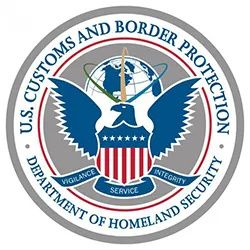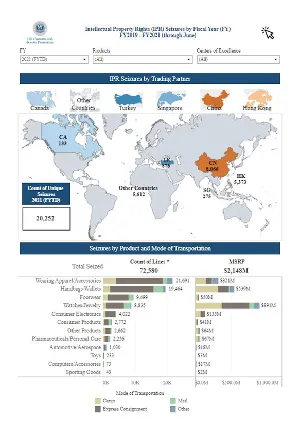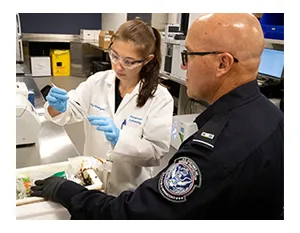In this Update
CBP Access is an electronic newspage developed by the Office of Congressional Affairs for Members of Congress and staff. If you are interested in subscribing to the CBP Access email distribution list, please send an email to OCAInquiry@cbp.dhs.gov.
Message from CBP Commissioner Chris Magnus

It is a deep honor to assume the post of CBP Commissioner and lead one of the Nation’s premier federal law enforcement agencies. While in some respects CBP is a young agency – created in response to the September 11, 2001, terrorist attacks – its legacy agencies have historic roots leading back to our Nation’s earliest origins. CBP is a proud agency with a mission that is simply vital to the security, safety, and economic well-being of this great country, and I am proud to lead such a critical organization and serve alongside those who are also dedicated to this important mission.
Over the course of my 40-year career in law enforcement I have always prioritized building relationships with the communities we serve, partnering with others to advance and expand efforts, implementing evidence-based best practices, promoting reform, and insisting on accountability and transparency. I will maintain these priorities as CBP Commissioner and believe that by working closely with Congress, the men and women who serve CBP, and its government-, public-, and private-sector partners, that we can build upon the Agency’s proven capabilities and strengths. Together we can implement effective solutions and take action to address our most pressing issues, including the interception of dangerous opioids such as fentanyl, identifying and prohibiting forced labor and counterfeit products in our supply chains, and addressing unauthorized migration. It is also my priority to ensure the well-being of the CBP workforce, especially in these pandemic times.
Soon after my confirmation CBP released Fiscal Year 2021 agency statistics for all major operational activities, including international travel and trade, forced labor enforcement, drug seizures, and border encounters. For me, statistics like these are not only important for agency transparency, but also to illustrate the vast scope of CBP's mission, activities, and responsibilities and highlight the remarkable successes of CBP's dedicated personnel during a year filled with numerous and unprecedented challenges. I look forward to working with Congress to support and build on these accomplishments this coming year and beyond.
–Chris Magnus, Commissioner
CBP Releases Fiscal Year 2021 Operational Statistics 
CBP’s broad and complex mission is not only vital to the security and safety of our country, but also integral to the recovery and growth of our economy. On January 3, 2022, CBP released agency statistics for Fiscal Year 2021 covering all major areas of operations, including international travel and trade, forced labor enforcement, drug seizures, and national border encounter statistics.
These latest statistics demonstrate that, in a year of numerous challenges, CBP’s dedicated personnel continued to protect our country by stopping dangerous people, products, and drugs from entering the United States, while facilitating the lawful movement of travelers and commerce across our borders.
At and in between our nation’s ports of entry, CBP officers, Border Patrol agents, and Air and Marine Operations agents continued to interdict illicit drugs at the border. Compared to last fiscal year, cocaine seizures increased 68%; methamphetamine seizures increased 7%; heroin seizures decreased 6%; and fentanyl seizures increased 134%. CBP continued to invest in forward operating laboratories that enable CBP scientists to analyze suspected substances on-site at ports of entry, allowing CBP and its partner law enforcement agencies to quickly make seizures or start investigations.
While CBP’s trade and travel numbers have not entirely returned to pre-pandemic levels, both traveler and conveyance volumes have increased significantly in recent months. For example, CBP processed more than three times as many international air travelers during the spring and summer of 2021 compared to the same period the year before.
CBP also ensured that legitimate trade continued to flow across our border. In FY 2021, CBP processed approximately $2.8 trillion of imports and collected approximately $93.8 billion in duties, taxes, and other fees on behalf of the U.S. government. CBP works closely with the trade community to strengthen international supply chains, enforce trade laws, and improve border security. This past fiscal year, CBP seized more than 83,000 shipments for trade violations, including counterfeit and pirated goods and goods made by forced labor.
CBP faced significant nationwide challenges at the border in FY 2021, grappling with the continuing COVID-19 pandemic – which deeply affected the health and well-being of its workforce – while confronting a high number of Southwest Border encounters (and repeat encounters) and changing migrant demographics. In FY 2021, CBP recorded a total of 1.72 million enforcement encounters along the Southwest Border, including 146,054 encounters of unaccompanied children, 478,492 encounters of individuals in family units, and 1,098,500 encounters of single adults. The majority of all encounters were processed in accordance with orders from the CDC under its Title 42 public health authority to limit the spread of COVID-19. The number of total encounters overstates the number of unique individuals attempting to cross the border. Since CBP began expelling noncitizens under the CDC’s Title 42 public health order, the repeat encounter rate jumped to more than one in three encounters, including almost half of single adult encounters.

This one displays Intellectual Property Rights
Seizures by Fiscal Year.
Attempting to cross the border between the ports of entry is tremendously dangerous. Since the start of FY 2021, CBP officers and agents have rescued more than 13,200 individuals in a wide variety of circumstances. CBP officers and agents continue to stand ready to provide lifesaving assistance to all who need it.
The statistics provided above are merely a sampling of the fiscal year data available. Please read the National Media Release on CBP’s Operational Statistics for FY 2021 and explore all of CBP’s available agency data on CBP.gov.
CBP Data Dashboards
CBP continues to increase data transparency and availability by publishing dynamic data dashboards that gather multiple historical and current data sources into a single interface and allow users to filter, sort, and visualize CBP’s wide range of operational figures. CBP currently has dynamic data dashboards for:
- Drug Seizure Statistics
- Southwest Land Border Encounters
- Southwest Land Border Encounters (By Component)
- Nationwide Encounters
- Assaults and Use of Force
- Currency and other Monetary Instrument Seizures
- Intellectual Property Rights Seizures
- Traveler and Conveyance Statistics
- Air and Marine Operations Drug Seizures
CBP will continue to publish additional data sets and dashboards as part of our commitment to strengthen public trust, and to increase public awareness and understanding of CBP operations.
How CBP Scientists Help Stem the Flow of Dangerous Drugs at the Border
 On a typical day, CBP seizes approximately 5,000 pounds of illegal drugs that would otherwise make their way into American communities. Marijuana, methamphetamine, heroin, and cocaine remain top-seized drugs, but shifting trends over recent years have produced significant increases in other drugs like fentanyl, a synthetic opioid that is 80-100 times stronger than morphine. Fentanyl is often mixed with heroin and/or cocaine as a combination product, often unbeknownst to the user, to increase its euphoric effects – which often results in overdose deaths.
On a typical day, CBP seizes approximately 5,000 pounds of illegal drugs that would otherwise make their way into American communities. Marijuana, methamphetamine, heroin, and cocaine remain top-seized drugs, but shifting trends over recent years have produced significant increases in other drugs like fentanyl, a synthetic opioid that is 80-100 times stronger than morphine. Fentanyl is often mixed with heroin and/or cocaine as a combination product, often unbeknownst to the user, to increase its euphoric effects – which often results in overdose deaths.
Compared to cocaine or methamphetamine, CBP seizures of fentanyl are relatively low. However, these seizures have increased dramatically in recent years. In Fiscal Year 2020, CBP seized approximately 4,700 pounds of fentanyl; last fiscal year, CBP seized more than 11,200 pounds.
Most of the fentanyl enters the United States through ports of entry along our southwest border. It’s brought in by privately owned vehicles, commercial vehicles, and even pedestrians. Although less frequent, fentanyl also enters through international mail packages and express consignment environments.
CBP has a multi-layered enforcement strategy to combat the cross-border movement of illegal drugs, involving partnerships, laboratory capabilities, technology, canines, and highly trained officers.
A recent article in Frontline, CBP’s official magazine, describes the shifting trends in the type of drugs smuggled and methods of smuggling, and how critical timing is when it comes to stopping the flow of illicit drugs from entering the United States.
For the past three years, CBP has been increasing its ability to swiftly identify suspected drugs by locating agency laboratory scientists on-site at U.S. ports of entry. What started as a special operation to target and stem the flow of fentanyl and other narcotics has proven to be not only an effective and valuable part of CBP’s ability to identify and seize illegal substances, but also a critical tool for partner agencies such as Homeland Security Investigations to make law enforcement-controlled deliveries that could potentially lead to arrests and shutdown dealers and their networks.
The on-site labs provide multiple benefits including helping CBP identify trends. For example, starting in October 2020, the forward operating labs began seeing an increased amount of N,N-dimethyltryptamine, or DMT, a hallucinogenic drug smuggled across the border. Another trend that the forward operating labs recently discovered is a new fentanyl analogue coming across the Southwest border. Many of CBP’s forward operating labs are along the Southwest border, but also in locations such as Chicago, Miami, Detroit, Los Angeles, and Puerto Rico.
Read more about how CBP scientists are working side-by-side with front line officers to stem the flow of dangerous drugs and keep America safe in Crisis Control: How CBP's Scientists are Stemming the Flow of Opioids and Other Dangerous Drugs at the Border.
CBP Detains Imports for Suspected Forced Labor
 Effective December 20, 2021, CBP personnel at all U.S. ports of entry will detain disposable gloves produced in Malaysia by Brightway Holdings Sdn Bhd, Laglove (M) Sdn Bhd, and Biopro (M) Sdn Bhd (collectively, Brightway Group).
Effective December 20, 2021, CBP personnel at all U.S. ports of entry will detain disposable gloves produced in Malaysia by Brightway Holdings Sdn Bhd, Laglove (M) Sdn Bhd, and Biopro (M) Sdn Bhd (collectively, Brightway Group).
CBP issued a Withhold Release Order against Brightway Group based on information that reasonably indicates the use of forced labor in that entity’s manufacturing operations. CBP identified 10 of the 11 International Labour Organization’s indicators of forced labor during its investigation.
“Forced Labor is a human rights abuse inflicted upon 25 million people worldwide,” said Chris Magnus, CBP Commissioner. “CBP will not allow goods tainted with forced labor to make their way into American households and businesses.”
Federal statute 19 U.S.C. 1307 prohibits the importation of merchandise produced, wholly or in part, by convict labor, forced labor, and/or indentured labor, including forced or indentured child labor. CBP detains shipments of goods suspected of being imported in violation of this statute. Importers of detained shipments can export their shipments or demonstrate that the merchandise was not produced with forced labor.
CBP continues to aggressively investigate and prevent goods made by forced labor from entering U.S. commerce. CBP issued seven Withhold Release Orders in Fiscal Year 2021 to protect American consumers and businesses from goods made by forced labor. Those orders have targeted cotton products and tomato products from China’s Xinjiang Uyghur Autonomous Region; silica-based products made by a company that operates in Xinjiang; palm oil from a Malaysian company; and tuna and other seafood harvested by a Chinese fishing fleet, a Taiwan-flagged fishing vessel, and a Fijian-flagged fishing vessel. In FY2021, CBP detained 1,469 shipments that contained approximately $486 million of goods suspected to be made by forced labor.
Any person or organization that has reason to believe merchandise produced with the use of forced labor is being, or likely to be, imported into the United States can report detailed allegations by contacting CBP through the e-Allegations Online Trade Violation Reporting System or by calling 1-800-BE-ALERT.
Enforcement News From Across CBP
U.S. Border Patrol Agents Seize Fentanyl and Meth at Highway Checkpoint

Salton City, CA — On Monday, January 10, 2022, El Centro Sector Border Patrol agents arrested two United States citizens attempting to smuggle close to $175,693 worth of narcotics through an immigration checkpoint. At approximately 9:20 p.m., a 2017 white Kia Forte 5 approached the Highway 86 checkpoint. The agent inspecting vehicles in the primary lanes referred the vehicle to secondary inspection. A Border Patrol K-9 detection team alerted agents to the rear of the vehicle. Agents inspected the trunk of the vehicle and discovered multiple boxes of contraband. The contents of the boxes contained pills that tested positive for fentanyl and a white crystal substance that tested positive for methamphetamine. The driver and passenger both 19-year-old females, were in possession of 7.8 pounds of fentanyl with an estimated street value at $115,375, and 39.5 pounds of methamphetamine with an estimated street value at $60,318.
CBP, Partners Intercept 1,470 Pounds of Cocaine Near St. Croix

St. Thomas, VI — On January, 9, 2022, CBP Air and Marine Operations (AMO) agents, along with HSI and the Drug Enforcement Administration (DEA), intercepted a vessel with four citizens of the British Virgin Islands found transporting 1,470 pounds of cocaine. The estimated value of the contraband is nearly $20 million. During the afternoon, an AMO Multirole Enforcement Aircraft (MEA) crew patrolling the east side of the United States Virgin Islands, detected a twin-engine boat at high speed. Suspected contraband was noticeable on the boat deck. The MEA crew assisted an AMO St. Thomas Coastal Interceptor Vessel crew and a U.S. Coast Guard Small Boat in stopping the 32’ Manta vessel 20 nautical miles east of St. Croix. The four men in the vessel were subsequently arrested for narcotics violations. The investigation is led by HSI St. Croix with the assistance of CBP AMO St. Thomas, HSI St. Thomas, DEA St. Thomas and DEA St. Croix.
CBP Seizes Dangerous Ketamine at Dulles International Airport

Dulles, VA — On December 25, 2021, CBP officers intercepted ketamine, a dangerous substance sometimes used as a club drug and in sexual assaults, when they unwrapped an express delivery parcel from Austria on Christmas day. While conducting routine examinations of arriving international parcels, officers examined a package manifested as “merchandise, writing board” that was destined to an address in Flushing, N.Y., and observed that the package was unusually heavy. Officers then opened the package and probed the side of one writing board. Officers discovered a white, powdery substance that field-tested positive for the presence of ketamine hydrochloride. CBP officers did not extract the ketamine, but seized the writing boards and turned them over to special agents from HSI. Ketamine, commonly known as Special K, delivers hallucinogenic effects, distorts perceptions, causes amnesia, temporary paralysis, and dangerously slows breathing, potentially shutting down body systems and leading to cardiac arrest or respiratory failure.
Office of Congressional Affairs | January 2022

